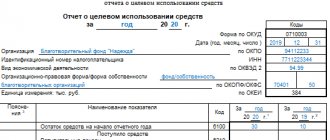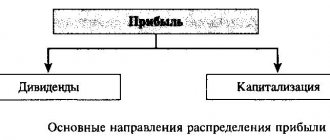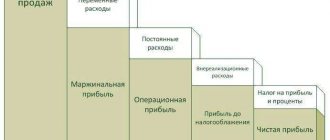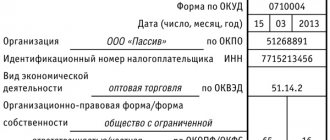Concept of form, who passes
Form 12-F is a document that every organization must submit to the state statistics agency according to the region in which the enterprise operates. To be fair, it should be noted that there are so-called exceptions to the rule.
The following types of business entities are not required to submit this form:
- Small businesses. Let me remind you that small enterprises include enterprises with no more than one hundred employees, with annual revenue of no more than 800 million and with a limited share of participation in such an enterprise by other persons.
- Non-state pension funds;
- Banks and other credit organizations;
- State and municipal institutions;
- Insurance companies.
Important! If an enterprise has separate divisions - branches or representative offices, then such divisions must submit this report at the place of business activity.
Form 12-F instructions for filling out
Time of arrival of the cargo at the destination station ___________________ 5. Time of delivery of the cargo to the oil depot _________________________________ 6. Technical condition of the tanks _________________________________ 7. Seals ___________________________________ presence and condition of sealing gaskets ________________ their condition _______________ 8. The mass of the cargo is determined ________________________________________________ (indicate the method of determination) contents of the prints ___________________________________________________ 9. To invoices are attached (not attached) passports N ______________ 10. Measuring instruments are checked in the prescribed manner (not checked) _________________________________________________________________ 11. Acceptance start time __________________ hours ___________ min. and the end of acceptance __________ hours __________ minutes. When opening the tanks and checking the mass, the following was found: ———————————————————————————————————————— ¦Yes- ¦ N ¦ N ¦Control-¦ Indicators for shipping ¦ In fact it turned out ¦ Result ¦For- ¦ ¦that ¦va- ¦signs¦ documents ¦ +—————+pol-¦ ¦delivery ¦go- ¦lad-¦seal +————————————-+————————————-+shortage¦iz- ¦ ¦equal-¦on , ¦noy +———+type ¦uro-¦plot-¦tem-¦mas- ¦Co- ¦mas-¦type ¦uro-¦plot-¦tem-¦mas- ¦% ¦kg¦mas-+— ——+ deprived ¦sa ¦all-¦v ¦ki ¦VU ¦ ¦nia ¦ter-¦ ¦od- ¦other. ¦ter-¦for- ¦kg/ ¦ra- ¦brut-¦zha- ¦no-¦ter-¦for- ¦kg/ ¦ra- ¦brut-¦ ¦ ¦no-¦go ¦including¦ ¦ ¦ ¦ ¦ny ¦ ¦noy ¦hundred-¦ny ¦half-¦cub. ¦tu- ¦to, ¦nie ¦to, ¦ny ¦half-¦cub.m¦tu- ¦to, ¦ ¦ ¦to, ¦ ¦in ¦ ¦ ¦ ¦ ¦ ¦ ¦hundred-¦rons¦ ¦not- ¦ m ¦ra, ¦kg ¦water ¦kg ¦ ¦non- ¦ ¦ra, ¦kg ¦ ¦ ¦kg ¦ ¦pre-¦ ¦ ¦ ¦ ¦ ¦ ¦rons¦ ¦ ¦nia,¦ ¦gra-¦ +——+ ¦ ¦nia,¦ ¦gra-¦ ¦ ¦ ¦ ¦ ¦de- ¦ ¦ ¦ ¦ ¦ ¦ ¦ ¦ ¦ ¦mm ¦ ¦du- ¦ ¦% kg¦ ¦ ¦mm ¦ ¦du- ¦ ¦ ¦ ¦ ¦ lah ¦ ¦ ¦ ¦ ¦ ¦ ¦ ¦ ¦ ¦ ¦ ¦ ¦ ¦ ¦ ¦ ¦ ¦ ¦ ¦ ¦ ¦ ¦ ¦ ¦nor-¦ ¦ ¦ ¦ ¦ ¦ ¦ ¦ ¦ ¦ ¦С ¦ ¦ ¦ ¦ ¦ ¦ ¦ ¦С ¦ ¦ ¦ ¦ ¦ ¦we ¦ ¦ ¦ +—-+—-+—-+—-+—-+—-+—-+——+—-+——+—+—+—- +—-+—-+——+—-+——+—+—+—-+—-+—-+—-+—-+ ¦ 1 ¦ 2 ¦ 3 ¦ 4 ¦ 5 ¦ 6 ¦ 7 ¦ 8¦ 9¦ 10¦11¦12¦13¦14¦ 15¦ 16¦ 17¦ 18¦19¦20¦ 21¦ 22¦ 23¦ 24¦ 25¦ ——+—-+—-+—-+—- +—-+—-+——+—-+——+—+—+—-+—-+—-+——+—-+——+—+—+—-+—-+—- +—-+—— 12. The missing quantity in the wagons (tanks) could not fit ——— (cross out what is unnecessary) could not 13. Documents attached to the act ________________________________ 14. The commission is familiar with the rules for accepting products by quantity. All persons involved in the acceptance are warned that they are responsible for the accuracy of the data set out in the act. Persons who participated in the preparation of the act: ____________________ _____________________ ____________________ (signature) (signature) (signature)
Source - Instruction of the USSR State Oil Product Committee dated August 15, 1985 No. 06/21-8-446
Legislative regulation
Form 12-F in its modern version was approved by Rosstat Order No. 509 dated August 1, 2017. A sample of it can be downloaded here:
Form 12 f
This order of Rosstat describes in detail who must submit 12-F reports, what exceptions there are, and also provides detailed recommendations for filling out this declaration.
Important! Form 12-F is precisely a statistical form of monitoring the activities of business entities and is not a tax return.
Methods for filing a declaration
This report form can be taken to the statistics agency during a personal visit or sent using an electronic submission form. The submission deadline is the same for both electronic submission and paper submission of the report.
Important! If you submit a report in paper form, print out two copies of the report and ask the specialist who accepted this document from you to put a mark on your copy indicating that the statistics agency accepted this report from you. This is done so that if the statistics authorities lose your report, you will have proof that you submitted it.
Important! If a report on Form 12-F is not submitted, the statistics agency may impose a fine on the organization that did not provide the document.
Information about the use of funds. Form 12-F
293 >= page 294; page 294 >= sums of lines 295 to 297; page 303 >= sums pages 306 to 312; 314; 316; 318; 320. Page 312 >= page 313; page 314 >= page 315; p. 316 >= p. 317; p. 318 >= p. 319; p. 320 >= p. 321; page 322 >= page 323.
Appendix No. 4 to the Instructions on the procedure for receipt, storage, release and accounting of oil and petroleum products at oil depots, loading points and gas stations of the USSR State Oil Products Committee
Goskomnefteprodukt ________________ Form N 12-NP ________________________ management _________________________ oil depot Approved by the Goskomnefteprodukt USSR on August 15, 1985 N 06/21-8-446 Approved by the Director of the oil depot __________________ __________ 19__
ACT N ______ ACCEPTANCE OF PETROLEUM PRODUCTS BY QUANTITY FROM __________ 19__
We, the undersigned _________________________________________________ representative of the enterprise _______________________________ t. ________, (name of the enterprise, full name) acting on the basis of certificate N ______________ dated __________, public representative of the oil depot _________________________________ (position) t. ______________, acting on the basis of certificate N __________ dated _______________ , issued in accordance with the decision of the trade union committee dated ___________ protocol N __________, drew up this act in that upon acceptance of ________________________________________________ (name of cargo) code __________, shipped from the station ______________________________, the following turned out to be: 1. Name and address of the shipper ________________________ 2. Name and address supplier ______________________________ 3. Place of acceptance - access road at the station ___________________ 4.
Filling out the form
Completing the cover page of Form 12-F includes making entries about:
- The name of the organization submitting the declaration (including full and short names);
- Address of the location of the enterprise;
- OKPO code of the organization. Note that the OKPO code, like other statistics codes, can be found on the state statistics website by indicating there your taxpayer identification number or ORGN;
- The year for which the report was compiled.
After filling out the title page, we proceed to filling out the form itself, which consists mainly of listing expenses, that is, how the company’s funds were spent in the reporting year.
Expenses are divided into main groups and their subgroups.
These main spending groups include: (click to expand)
- Entertainment expenses;
- Business maintenance expenses;
- Employee benefits;
- Financing investments on a long-term basis.
For each expense item and its subitem, you must indicate the amount of money spent by the legal entity.
Important! In this form of statistical observation, you need not only to indicate the presence and amount of money spent, but also to separate from the amount of expenses the amount of money spent from net profit.
We sign Form 12-F by the director of the organization or another person who is appointed as the unified executive body of the organization and is responsible for submitting statistical reports.
Form 12-F. Information about the use of funds
5. The determination of the number of workers engaged in heavy physical labor (line 09) is carried out in accordance with the hygienic standard of physical activity when performing work for men and women, contained in the Hygienic Criteria for Assessing Working Conditions N P2.2.013-94. The severity of physical labor is assessed by physical dynamic load, the mass of the load being lifted and moved, stereotypical working movements, static load, body tilt, and movements in space.
6. Line 10 takes into account those working on equipment, machines, mechanisms that do not meet the requirements of the system of labor safety standards.
7. Data on employees is included in lines 02 - 10, regardless of whether these employees receive benefits for unfavorable working conditions or not.
Section II. Benefits and compensation for working in unfavorable working conditions
8. Section II provides data on workers, managers, specialists and employees receiving benefits and compensation for working in unfavorable working conditions. Benefits for working in the Far North due to unfavorable natural conditions in connection with the accident at the Chernobyl nuclear power plant are not taken into account when filling out section II. Employees entitled to certain benefits who are engaged in teaching activities in institutions for children, medical care and other health care work are not taken into account.
9. Line 12 shows the number of employees taking additional leave for work under hazardous working conditions.
Since January 1, 1992, a minimum annual paid leave of 24 working days has been established. At the same time, until the adoption of new legislation on vacations, the procedure and conditions for granting additional vacations provided for by law remain the same. Line 12 shows the number of employees whose total leave (12 working days) and additional leave for work in hazardous conditions exceeds 24 working days.
10. Line 13 shows employees using a shortened working day in accordance with the current “List of industries, workshops, professions and positions with hazardous working conditions, work in which gives the right to additional leave and a shortened working day,” approved by the Resolution of the State Committee of Labor of the USSR and the All-Union Central Council of Trade Unions dated 10.25.74 with subsequent additions and changes to it, as well as those for whom the organization itself established a shortened working day for working in unfavorable working conditions.
11. Line 14 shows the number of workers receiving free medical and preventive nutrition in accordance with the current “List of industries, professions and positions in which work gives the right to receive free medical and preventive nutrition in connection with particularly harmful working conditions”, approved by the Resolution State Labor Committee of the USSR and the All-Russian Central Council of Trade Unions dated 01/07/77.
12. Line 15 shows the number of workers who receive milk or other equivalent food products free of charge due to hazardous working conditions in accordance with the list of jobs and professions established independently by the administration of the enterprise in agreement with the local trade union organization based on the list of chemicals when working with which, for preventive purposes, recommend the consumption of milk or other equivalent food products, approved by the Ministry of Health of the USSR 04.11.87 N 4430-87 and currently in force.
13. Line 16 shows the number of employees whose wages are based on increased tariff rates (salaries) established for work with difficult and harmful working conditions and for work with especially difficult and especially harmful working conditions.
Line 16 includes employees who receive additional payments for work in unfavorable working conditions, established by the organization as a result of workplace certification or special measurements of the levels of working environment factors in the workplace.
Line 16 also includes the number of workers working on conveyors, production and automatic lines, who receive additional payments for labor intensity.
14. Lines 17 - 19 show the number of workers employed in jobs with difficult and hazardous working conditions, in industries, industries, workshops, professions, positions, work in which is based on the Law of the RSFSR “On State Pensions in the RSFSR” and its amendments gives the right to a state pension on preferential terms, including pensioners working in these industries.
Line 19 shows the number of workers entitled to a preferential pension due to special working conditions (Article 12, paragraphs “B - D”, “G - K” of the Law): women working as tractor drivers, as well as construction drivers , road and loading and unloading machines; textile workers; workers of locomotive crews and certain categories of workers who directly organize transportation and ensure traffic safety on railway transport and the metro; truck drivers directly involved in the technological process in mines, mines, open-pit mines and open-pit mines for the removal of coal, shale, ore, and rock; workers, craftsmen directly involved in logging and timber rafting; machine operators (dockers - machine operators) of integrated teams for loading and unloading operations in ports; the crew of the sea, river and fishing industry fleets; drivers of buses, trolleybuses, trams on regular city passenger routes.
Line 19 also shows the number of workers entitled to a preferential pension for long service: those employed in underground and open-pit mining operations for the extraction of coal, shale, ore and other minerals and in the construction of mines and mines (Article 78 of the Law), working in civil aviation (Article 79 of the Law), working on vessels of the fishing industry fleet, sea and river fleet (Article 78 of the Law).
Line 20 shows the number of employees entitled to a preferential pension established by the organization itself for difficult and harmful working conditions. Lines 17 - 20 also show persons who have already exercised the right to receive a pension on preferential terms and continue to work in the same places.
When filling out lines 17 - 20, you must keep in mind that each employee is counted only once, regardless of the possibility of receiving a pension on preferential terms for several reasons.
15. Line 21 shows the number of employees who have at least one of the above benefits and compensations for unfavorable working conditions, while the employee is counted only once, regardless of whether he uses one or more types of benefits and compensation.
* * *
With the introduction of this Instruction, the previously in force Instructions for compiling statistical reporting on the state of working conditions, benefits and compensation for work in unfavorable working conditions (Form No. 1-t (working conditions)), approved by Resolution of the State Statistics Committee of Russia dated July 12, 1994 No. 104, are cancelled.
- home
- DECREE of the State Statistics Committee of the Russian Federation dated July 31, 1996 N 91 “On PRESERVATION OF THE FORM OF STATE STATISTICAL REPORTING ON THE STATE OF LABOR CONDITIONS AND APPROVAL OF INSTRUCTIONS FOR ITS COMPLETION”
Form 12-F Information on the use of funds is submitted by legal entities, regardless of the form of ownership (except for small businesses, banks, insurance and budgetary organizations) at their location to the territorial body of Rosstat. The statistical report must be provided annually.
Form 12-F was approved by Rosstat order No. 247 dated July 13, 2010.
The form includes information on the legal entity as a whole.
If a legal entity has separate divisions allocated to a separate balance sheet, keeping records of revenue from the sale of goods, products, works, services and expenses for the production and sale of goods, products, works, services, this form is filled out both for each such separate division and and by legal entity with the exception of these separate divisions.
The completed forms are submitted by the legal entity to the territorial bodies of Rosstat at the location of the corresponding separate division (for a separate division) and at the location of the legal entity (without separate divisions).
The head of a legal entity appoints officials authorized to provide statistical information on behalf of the legal entity.
The address part indicates the full name of the reporting organization in accordance with the constituent documents registered in the prescribed manner, and then the short name in brackets. The form containing information on a separate division of a legal entity indicates the name of the separate division and the legal entity to which it belongs.
The line “Postal address” indicates the name of the subject of the Russian Federation, legal address with postal code; if the actual address does not coincide with the legal address, then the actual postal address is also indicated. For separate divisions that do not have a legal address, a postal address with a postal code is indicated.
A legal entity enters the code of the All-Russian Classifier of Enterprises and Organizations (OKPO) in the code part of the form on the basis of the Notification of assignment of the OKPO code sent (issued) to organizations by the territorial bodies of Rosstat.
For territorially separate subdivisions of a legal entity, an identification number is indicated, which is established by the territorial body of Rosstat at the location of the territorially separate subdivision.
How to fill out the form
Column 3 of this form shows the total amount of money spent, while the expenses do not include the movement between the items that make up the money; in column 4 - expenses incurred from the profits remaining at the disposal of the organization.
Line 293 shows the organization’s expenses for objects that will later be registered as fixed assets, including land plots and environmental management objects, intangible assets, as well as the costs of forming the main herd of livestock.
Line 295 shows the organization’s expenses on objects that will be taken into account as fixed assets.
Line 296 shows the costs of purchasing and creating software, including large databases that are expected to be used for more than one year.
Line 297 shows expenses for research and development work. Expenses on scientific research and (or) experimental design developments are expenses related to the creation of new or improvement of manufactured products (goods, works, services), in particular the costs of invention. This indicator is filled out by organizations that carry out research and development work on their own and/or are contractual customers for the specified work.
Line 303 shows the expenses of service farms on the balance sheet of the organization, whose activities are not related to the production of products, performance of work and provision of services that were the purpose of creating this organization: residential buildings, dormitories, laundries, baths, canteens and buffets; children's preschool institutions (kindergartens, nurseries), rest homes, sanatoriums and other health, cultural and educational institutions.
Lines 306 - 311 reflect expenses for: lighting, heating, repairs and other expenses associated with the maintenance of these objects on the balance sheet of the organization.
Facilities for physical culture and health activities include baths, showers, solariums, sports and health complexes, swimming pools, skating rinks, etc.
Lines 312 - 321 reflect expenses directly related to the provision of services by service farms.
Line 322 reflects social payments. When determining the composition of payments, one should be guided by the instructions of the Federal State Statistics Service.
Line 324 shows funds transferred to environmental and health funds, public organizations of disabled people, religious organizations (associations), and for other similar purposes.
Line 325 shows funds transferred to separate structural units that have a separate balance sheet and current account. Line 325 is filled in only by legal entities.
Line 326 reflects the organization’s actually paid expenses for receiving and serving representatives of other organizations (including foreign ones) who arrived for negotiations in order to establish and maintain mutual cooperation, as well as participants who arrived at meetings of the council (board) and audit commission of the organization.
Lines 327 and 328 reflect the actually paid services of banks and other financial and credit institutions for issuing wages to employees, services of credit institutions for carrying out trade commission (factoring) operations in accordance with concluded agreements; services of advertising agencies for the production and distribution of advertising, including participation in exhibitions and fairs; services of audit organizations related to the audit of the financial and economic activities of the organization.
Line 329 reflects contributions to industry and inter-industry extra-budgetary funds for research and development work.
Line 330, column 3 reflects the total amount of money spent.
Page 330 > sums of rows 293, 303, 322, 324, 325, 326, 327, 328, 329; p.
conclusions
The “Information on the use of funds” form is a way to collect information about business entities of territorial statistical bodies and includes information about the organization’s expenses, that is, for what purposes the enterprise’s funds were spent. The form is submitted annually and can be submitted in written or electronic form with the obligatory signing of the form with an electronic digital signature. For failure to submit this report, the organization may be subject to an administrative penalty in the form of a fine.






